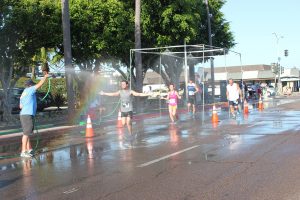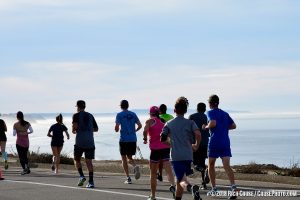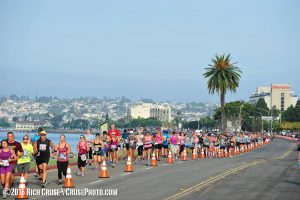Give us the sun, but not the heat. Give us cool temps, but no wind or rain. Just one light breeze topped with slightly overcast conditions and a side of temperatures in the 60’s, please and thanks!
We runners are particular creatures. But at the same time we’re willing to do crazy things to accomplish a goal, like run in all types of imperfect weather conditions. When training for winter races like the Carlsbad Marathon & Half in January, you get ideal race day weather but training days are often cold, dark and sometimes wet.
Then there’s the AFC Half Marathon in San Diego. The idealistic summertime race complete with sunshine, sparkling harbor/bay/ocean views, sailboats galore, misting stations, palm trees and oh yeah – warm weather!
Lookin’ hot 😎
“I love training in the heat” said no one ever! It’s not our favorite, but there are benefits to it as long as health and safety are always held as a priority.
Changing our perspective will always have a positive effect on our training because as we know, running is extremely mental. So if you start to view heat training as positive, you can embrace the “unpleasant-ness” of it. After all, gaining strength doesn’t happen by remaining comfortable, it’s when you’re especially uncomfortable that you start to get a training effect.
Benefits of heat training
Your body will learn to cool itself quicker (thanks sweat!)
Chris Minson, a professor of human physiology at the University of Oregon, found through his research that heat training creates inexplicable changes to the heart’s left ventricle, which helps to increase oxygen delivery to the muscles. In addition, he says that athletes who train in warm temperatures generally get better at regulating heat by sweating earlier or developing a colder resting body temperature.
You’ll become a more efficient runner and feel stronger in cooler temps
Get your vitamin D

Important reminders
Know your limit and don’t push yourself
One of the most important (and sometimes hardest) parts of running in warm weather is to not overdo it. Getting competitive with yourself and wanting to push may be your natural instinct, but for the sake of your well-being you need to fight that desire. Make a conscious effort to tune in to your body and check on your breathing.
Be compassionate with yourself
Prior to a warm weather workout or race day, adjust your expectations and prepare your mindset that you may need to slow down or even walk a little. Don’t let yourself feel badly or consider it a failure; it’s safety.
Additional resources to train and race your best:
- A concise “how to” guide on hydration and warm weather running
- Sodium replenishment suggestions, including a beer!



